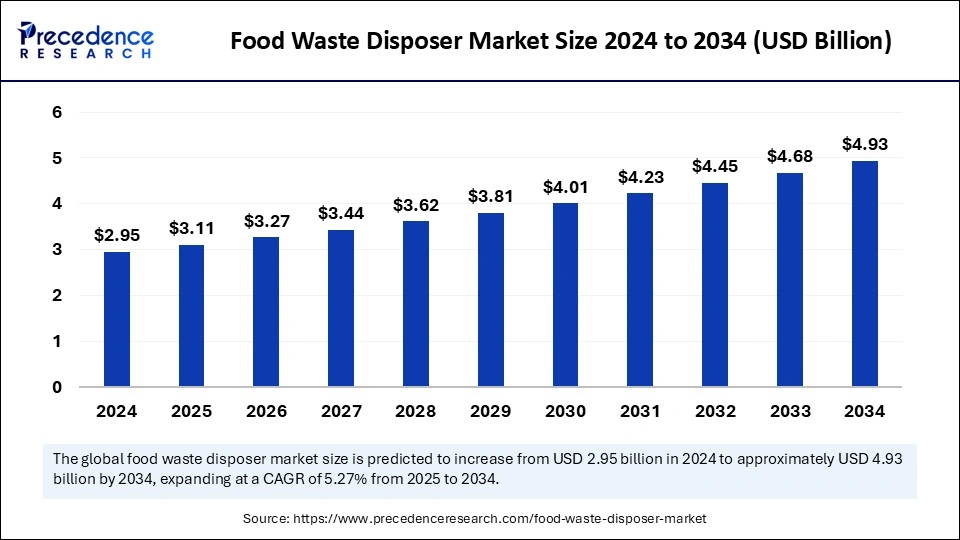Food waste disposer market is projected to grow at a CAGR of 5.27%, increasing from USD 2.95 billion in 2024 to USD 4.93 billion by 2034.

Food Waste Disposer Market Key Takeaways
-
In 2024, North America captured more than 38% of the market share.
-
Europe is projected to experience strong growth between 2024 and 2034.
-
The batch feed segment led the market by type in 2024.
-
Continuous feed systems are expected to expand significantly.
-
The residential segment contributed 50% of the market share by application in 2024.
-
The commercial segment is anticipated to grow at the highest rate.
-
Electric disposers dominated the market by technology in 2024.
-
Non-electric disposers are forecasted to grow rapidly during the studied period.
-
The household segment led the market by end use in 2024.
-
The restaurants segment is predicted to be the fastest-growing end-use segment.
Food Waste Disposer Market Overview
The food waste disposer market is gaining momentum globally due to rising environmental concerns, increasing adoption of sustainable waste management practices, and growing consumer awareness of the benefits of food waste disposers. Food waste disposers are devices installed in kitchen sinks that grind food waste into small particles, allowing it to pass through the plumbing system and reducing the volume of waste sent to landfills. These devices contribute to minimizing landfill waste, reducing greenhouse gas emissions, and promoting eco-friendly waste management solutions.
As governments and environmental agencies focus on reducing food waste and promoting sustainable practices, the adoption of food waste disposers in residential and commercial settings is increasing. The development of advanced technologies, including smart food waste disposers with IoT capabilities, is enhancing the functionality and efficiency of these systems. Additionally, the rising demand for energy-efficient and low-noise disposers is driving innovation in the market.
Market Drivers
-
Growing Environmental Awareness: Increasing public awareness regarding the environmental impact of food waste and the need for sustainable waste management practices is driving the demand for food waste disposers.
-
Government Regulations and Incentives: Governments across the globe are implementing strict regulations and offering incentives to promote the adoption of food waste disposers to reduce landfill waste.
-
Convenience and Hygiene Benefits: Food waste disposers offer convenience by eliminating food waste at the source, reducing odors, and maintaining kitchen hygiene, which is driving their adoption among homeowners.
-
Rising Demand for Sustainable Solutions in Commercial Kitchens: The increasing demand for sustainable waste management solutions in commercial kitchens, including restaurants, hotels, and cafeterias, is boosting the growth of the market.
Market Opportunities
-
Growing Adoption in Emerging Markets: The rising urban population, increasing disposable incomes, and growing awareness of sustainable waste management practices in emerging markets present significant growth opportunities.
-
Development of Smart and Connected Disposers: The integration of IoT technology and smart features in food waste disposers offers enhanced user control, predictive maintenance, and remote monitoring, creating new opportunities in the market.
-
Increasing Focus on Waste-to-Energy Solutions: The rising emphasis on converting food waste into biogas and other renewable energy sources presents opportunities for the integration of food waste disposers into waste-to-energy systems.
-
Expansion of Eco-Friendly and Water-Efficient Models: The development of eco-friendly and water-efficient food waste disposers is expected to attract environmentally conscious consumers and contribute to market growth.
Market Challenges
-
High Initial Investment and Maintenance Costs: The relatively high cost of purchasing and installing food waste disposers can limit their adoption, particularly in cost-sensitive markets.
-
Limited Infrastructure in Developing Regions: The lack of adequate waste management infrastructure in some developing regions poses a challenge to the widespread adoption of food waste disposers.
-
Concerns About Plumbing System Compatibility: Compatibility issues with existing plumbing systems and the need for modifications during installation can act as barriers to market penetration.
-
Regulatory and Environmental Compliance Issues: Compliance with wastewater regulations and concerns about the environmental impact of disposer-generated waste can pose challenges for manufacturers and users.
Regional Analysis
-
North America: North America is the largest market for food waste disposers, driven by high consumer awareness, advanced waste management infrastructure, and favorable government policies promoting sustainable waste disposal. The United States leads the region in terms of market share and adoption.
-
Europe: Europe holds a significant share of the market, with countries such as Germany, the UK, and France implementing stringent waste management regulations and promoting the use of food waste disposers as part of sustainable waste reduction initiatives.
-
Asia Pacific: The Asia Pacific region is witnessing rapid market growth due to increasing urbanization, rising disposable incomes, and growing awareness of sustainable waste management practices. China, Japan, and India are major contributors to the region’s growth.
-
Latin America: Latin America is gradually adopting food waste disposers, with Brazil and Mexico leading the region in the implementation of sustainable waste management practices.
-
Middle East and Africa: The Middle East and Africa region is experiencing moderate growth, with governments investing in waste management infrastructure and promoting eco-friendly waste disposal practices.
Recent News
-
A North American company launched a next-generation food waste disposer with advanced grinding technology and smart monitoring features, enhancing user experience and waste management efficiency.
-
The European Union introduced new funding initiatives to promote the adoption of food waste disposers across member states as part of its commitment to reducing landfill waste.
-
A leading Asian manufacturer unveiled an AI-powered food waste disposer designed to optimize waste management processes and minimize environmental impact.
Food Waste Disposer Market Companies
- Emerson Electric
- Whirlpool
- Rinnai
- Delta Faucet
- Franke
- Electrolux
- Smeg
- Moen
- Bosch
- InSinkErator
Segments Covered in the Report
By Type
- Batch Feed
- Continuous Feed
- Food Waste Grinder
By Application
- Residential
- Commercial
- Industrial
By Technology
- Electric Disposers
- Non-electric Disposers
- Biodegradable Disposers
By End-use
- Household
- Restaurants
- Food Processing Units
By Geography
- North America
- Europe
- Asia-Pacific
- Latin America
- Middle East & Africa